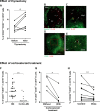Regulatory B cells in myasthenia gravis are differentially affected by therapies
- PMID: 30480034
- PMCID: PMC6243377
- DOI: 10.1002/acn3.645
Regulatory B cells in myasthenia gravis are differentially affected by therapies
Abstract
We analyzed the number and functionality of regulatory B (Breg) cells in well-defined myasthenia gravis patients. We first showed a decreased number of circulating CD19+ CD24++ CD38++ Breg cells and an altered functionality of Breg cells in untreated myasthenia gravis patients. Next, we demonstrated that the proportion of circulating Breg cells was restored in myasthenia gravis patients after thymectomy, probably as Breg cells could be sequestered in the myasthenia gravis thymus. In contrast, corticosteroid treatments did not restore and decreased even more the proportion of Breg cells in myasthenia gravis patients. These results clearly demonstrated that two distinct immunomodulatory therapies affect differentially Breg cells.
Figures


Similar articles
-
Regulatory B Cells Are Decreased and Functionally Impaired in Myasthenia Gravis Patients.Front Neurol. 2022 Feb 28;13:808322. doi: 10.3389/fneur.2022.808322. eCollection 2022. Front Neurol. 2022. PMID: 35295834 Free PMC article.
-
Thymectomy and systemic lupus erythematosus (SLE).Ann Ital Chir. 2014 Nov-Dec;85(6):617-8. Ann Ital Chir. 2014. PMID: 25919914
-
Significance of B10 cell in patients with thymoma complicated with myasthenia gravis.Oncotarget. 2017 May 17;8(43):73774-73786. doi: 10.18632/oncotarget.17908. eCollection 2017 Sep 26. Oncotarget. 2017. Retraction in: Oncotarget. 2023 Apr 10;14:294. doi: 10.18632/oncotarget.28160. PMID: 29088744 Free PMC article. Retracted.
-
[Treatment of myasthenia gravis].Rinsho Shinkeigaku. 1999 Dec;39(12):1222-5. Rinsho Shinkeigaku. 1999. PMID: 10791082 Review. Japanese.
-
[Therapeutic strategy in myasthenia gravis].Rev Neurol (Paris). 2009 Feb;165(2):149-54. doi: 10.1016/j.neurol.2009.01.005. Rev Neurol (Paris). 2009. PMID: 19233080 Review. French.
Cited by
-
Single-cell mass cytometry on peripheral cells in Myasthenia Gravis identifies dysregulation of innate immune cells.Front Immunol. 2023 Jan 30;14:1083218. doi: 10.3389/fimmu.2023.1083218. eCollection 2023. Front Immunol. 2023. PMID: 36793723 Free PMC article.
-
IgG4 Autoantibodies in Organ-Specific Autoimmunopathies: Reviewing Class Switching, Antibody-Producing Cells, and Specific Immunotherapies.Front Immunol. 2022 Mar 24;13:834342. doi: 10.3389/fimmu.2022.834342. eCollection 2022. Front Immunol. 2022. PMID: 35401530 Free PMC article. Review.
-
Editorial: Advances in Autoimmune Myasthenia Gravis.Front Immunol. 2020 Aug 28;11:1688. doi: 10.3389/fimmu.2020.01688. eCollection 2020. Front Immunol. 2020. PMID: 32983085 Free PMC article. No abstract available.
-
Roles of cytokines and T cells in the pathogenesis of myasthenia gravis.Clin Exp Immunol. 2021 Mar;203(3):366-374. doi: 10.1111/cei.13546. Epub 2020 Dec 3. Clin Exp Immunol. 2021. PMID: 33184844 Free PMC article. Review.
-
Regulatory B Cells Are Decreased and Functionally Impaired in Myasthenia Gravis Patients.Front Neurol. 2022 Feb 28;13:808322. doi: 10.3389/fneur.2022.808322. eCollection 2022. Front Neurol. 2022. PMID: 35295834 Free PMC article.
References
-
- Berrih‐Aknin S, Le Panse R. Myasthenia gravis: a comprehensive review of immune dysregulation and etiological mechanisms. J Autoimmun 2014;52:90–100. - PubMed
-
- Fillatreau S, Gray D, Anderton SM. Not always the bad guys: B cells as regulators of autoimmune pathology. Nat Rev Immunol 2008;8:391–397. - PubMed
-
- Rosser EC, Mauri C. Regulatory B cells: origin, phenotype, and function. Immunity 2015;42:607–612. - PubMed
LinkOut - more resources
Full Text Sources
Other Literature Sources
Medical
Research Materials

